The Indian Army is the land-based branch and the largest component of the Indian Armed Forces. The President of India is the Supreme Commander of the Indian Army, and its professional head is the Chief of Army Staff (COAS), who is a four-star general. Two officers have been conferred with the rank of field marshal, a five-star rank, which is a ceremonial position of great honour. The Indian Army originated from the armies of the East India Company, which eventually became the British Indian Army, and the armies of the princely states, which were merged into the national army after independence. The units and regiments of the Indian Army have diverse histories and have participated in a number of battles and campaigns around the world, earning many battle and theatre honours before and after Independence.
The primary mission of the Indian Army is to ensure national security and national unity, to defend the nation from external aggression and internal threats, and to maintain peace and security within its borders. It conducts humanitarian rescue operations during natural calamities and other disturbances, such as Operation Surya Hope, and can also be requisitioned by the government to cope with internal threats. It is a major component of national power, alongside the Indian Navy and the Indian Air Force. The army has been involved in four wars with neighbouring Pakistan and one with China. Other major operations undertaken by the army include Operation Vijay, Operation Meghdoot, and Operation Cactus. The army has conducted large peace time exercises such as Operation Brasstacks and Exercise Shoorveer, and it has also been an active participant in numerous United Nations peacekeeping missions, including those in Cyprus, Lebanon, Congo, Angola, Cambodia, Vietnam, Namibia, El Salvador, Liberia, Mozambique, South Sudan, and Somalia.
The Indian Army is operationally and geographically divided into seven commands, with the basic field formation being a division. Below the division level are permanent regiments that are responsible for their own recruiting and training. The army is an all-volunteer force and comprises more than 80% of the country's active defence personnel. It is the largest standing armyin the world, with 1,237,117 active troops and 960,000 reserve troops. The army has embarked on an infantry modernisation program known as Futuristic Infantry Soldier As a System (F-INSAS), and is also upgrading and acquiring new assets for its armoured, artillery, and aviation branches.
| Chief of the Army Staff | |
|---|---|
Commander-in-Chief, Indian Army (1947–1948)
| No. | Portrait | Name | Took office | Left office | Time in office | Unit of Commission |
|---|---|---|---|---|---|---|
| 1 | General Sir Robert Mcgregor Macdonald Lockhart, KCB, CIE, MC (1893–1981) [a] | 15 August 1947 | 31 December 1947 | 108 days | 51st Sikhs | |
| 2 | General Sir Francis Robert Roy Bucher, KBE, CB, MC (1895–1980) [a] | 1 January 1948 | 20 June 1948 | 171 days | 4th Cameronians |
Chief of the Army Staff and Commander-in-Chief, Indian Army (1948-1955)
| No. | Portrait | Name | Took office | Left office | Time in office | Unit of Commission | Ref |
|---|---|---|---|---|---|---|---|
| 1 | General Sir Francis Robert Roy Bucher, KBE, CB, MC (1895–1980) [a] | 21 June 1948 | 15 January 1949 | 208 days | 4th Cameronians | — | |
| 2 | General Kodandera Madappa Cariappa, OBE (1899–1993) | 15 January 1949 | 14 January 1953 | 3 years, 365 days | 88th Carnatic Infantry | — | |
| 3 | General Maharaj Shri Rajendrasinhji Jadeja, DSO (1899–1964) | 14 January 1953 | 1 April 1955 | 2 years, 77 days | 2nd Lancers (Gardner's Horse) | [6] |
Chief of the Army Staff (1955–present)
| No. | Portrait | Name | Took office | Left office | Time in office | Unit of Commission |
|---|---|---|---|---|---|---|
| 1 | General Maharaj Shri Rajendrasinhji Jadeja, DSO (1899–1964) | 1 April 1955 | 14 May 1955 | 43 days | 2nd Lancers (Gardner's Horse) | |
| 2 | General Satyawant Mallana Srinagesh (1903–1977) | 15 May 1955 | 7 May 1957 | 1 year, 357 days | 19th Hyderabad Regiment | |
| 3 | General Kodandera Subayya Thimayya, DSO (1906–1965) | 8 May 1957 | 7 May 1961 | 4 years, 0 days | 19th Hyderabad Regiment | |
| 4 | General Pran Nath Thapar (1906–1975) | 8 May 1961 | 19 November 1962 | 1 year, 195 days | 1st Punjab Regiment | |
| 5 | General Jayanto Nath Chaudhuri, OBE (1908–1983) | 20 November 1962 | 7 June 1966 | 3 years, 199 days | 16th Light Cavalry | |
| 6 | General Paramasiva Prabhakar Kumaramangalam, DSO, MBE (1913–2000) | 8 June 1966 | 7 June 1969 | 2 years, 364 days | Regiment of Artillery | |
| 7 | Field Marshal Sam Hormusji Framji Jamshedji Manekshaw, MC (1914–2008) | 8 June 1969 | 15 January 1973 | 3 years, 221 days | 12th Frontier Force Regiment | |
| 8 | General Gopal Gurunath Bewoor, PVSM (1916–1989) | 16 January 1973 | 31 May 1975 | 2 years, 135 days | Dogra Regiment | |
| 9 | General Tapishwar Narain Raina, MVC, SM (1921–1980) | 1 June 1975 | 31 May 1978 | 2 years, 364 days | Kumaon Regiment | |
| 10 | General Om Prakash Malhotra, PVSM (1922–2015) | 1 June 1978 | 31 May 1981 | 2 years, 364 days | Regiment of Artillery | |
| 11 | General Kotikalapudi Venkata Krishna Rao, PVSM (1923–2016) | 1 June 1981 | 31 July 1983 | 1 year, 364 days | Mahar Regiment | |
| 12 | General Arunkumar Shridhar Vaidya, PVSM, MVC, AVSM (1926–1986) | 1 August 1983 | 31 January 1986 | 2 years, 244 days | 9th Deccan Horse | |
| 13 | General Krishnaswamy Sundarji, PVSM (1928–1999) | 1 February 1986 | 31 May 1988 | 2 years, 120 days | Mahar Regiment | |
| 14 | General Vishwa Nath Sharma, PVSM, AVSM, ADC (born 1930) | 1 June 1988 | 30 June 1990 | 2 years, 29 days | 16th Light Cavalry | |
| 15 | General Sunith Francis Rodrigues, PVSM, VSM (born 1933) | 1 July 1990 | 30 June 1993 | 2 years, 364 days | Regiment of Artillery | |
| 16 | General Bipin Chandra Joshi, PVSM, AVSM, ADC (1935–1994) | 1 July 1993 | 19 November 1994 | 1 year, 141 days | 64th Cavalry | |
| 17 | General Shankar Roy Chowdhary, PVSM, ADC (born 1937) | 20 November 1994 | 30 September 1997 | 2 years, 314 days | 20th Lancers | |
| 18 | General Ved Prakash Malik, PVSM, AVSM (born 1939) | 1 October 1997 | 30 September 2000 | 2 years, 365 days | Sikh Light Infantry | |
| 19 | General Sundararajan Padmanabhan, PVSM, AVSM, VSM (born 1940) | 1 October 2000 | 31 December 2002 | 2 years, 91 days | Regiment of Artillery | |
| 20 | General Nirmal Chander Vij PVSM, UYSM, AVSM (born 1943) | 1 January 2003 | 31 January 2005 | 2 years, 30 days | Dogra Regiment | |
| 21 | General Joginder Jaswant Singh, PVSM, AVSM, VSM, ADC (born 1945) | 1 February 2005 | 30 September 2007 | 2 years, 241 days | Maratha Light Infantry | |
| 22 | General Deepak Kapoor, PVSM, AVSM, SM, VSM, ADC (born 1948) | 1 October 2007 | 31 March 2010 | 2 years, 181 days | Regiment of Artillery | |
| 23 | General Vijay Kumar Singh, PVSM, AVSM, YSM, ADC (born 1951) | 1 April 2010 | 31 May 2012 | 2 years, 60 days | Rajput Regiment | |
| 24 | General Bikram Singh PVSM, UYSM, AVSM, SM, VSM, ADC (born 1952) | 1 June 2012 | 31 July 2014 | 2 years, 60 days | Sikh Light Infantry | |
| 25 | General Dalbir Singh Suhag, PVSM, UYSM, AVSM, VSM, ADC (born 1954) | 1 August 2014 | 31 December 2016 | 2 years, 152 days | 5 Gorkha Rifles | |
| 26 | General Bipin Rawat, PVSM, UYSM, AVSM, YSM, SM, VSM, ADC (born 1958) | 31 December 2016 | 31 December 2019 | 3 years, 0 days | 11 Gorkha Rifles | |
| 27 | General Manoj Mukund Naravane, PVSM, AVSM, SM, VSM, ADC (born 1960) | 31 December 2019 | Incumbent | 1 year, 251 days | Sikh Light Infantry |








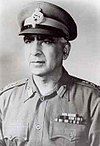





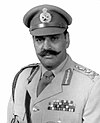



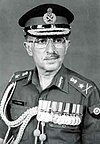





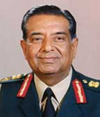

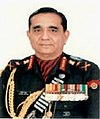

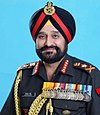







No comments:
Post a Comment